Louis Moreau Gottschalk was one of America’s first matinee idols and international superstars. A child prodigy as a pianist, he left his home city of New Orleans for Paris at the age of 12 to learn his craft. He soon became a sensation in Europe, America, and South America. Gottschalk has been called “America’s first authentic musical voice.” He was America’s first homegrown concert idol.
Gottschalk died in Brazil in 1869, at the age of 40. Leading an orchestra of almost 700 pieces in his composition, Morte, he collapsed on stage and died soon thereafter. A huge funeral was held in Rio de Janiero and he was interred there. However, his family soon brought his remains to Green-Wood. You will find earlier blog posts on Gottschalk here and here.
I recently came across this intriguing stereoscopic view for sale:
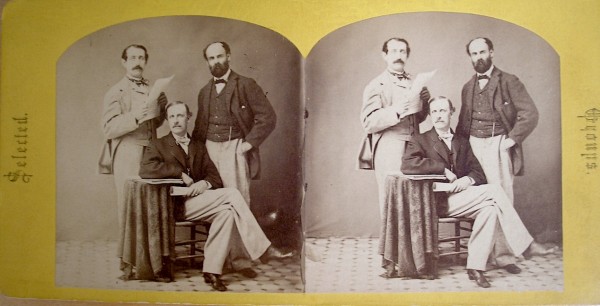
On the back of this card, in pencil, are two notations: “Gottschalk & Friends” and “Louis Moreau Gottschalk US Pianist & Composer 1829-69.” Fortunately, I was able to purchase it for the Green-Wood Historic Fund’s Collections.
I was, of course, curious about the “friends.” Gottschalk was clearly identifiable as the figure at left, in the light suit. No problem there. But who were the other two men?
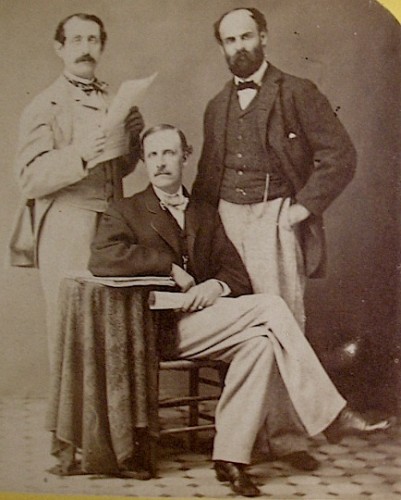
I considered this mystery and concluded that there was one man I knew who might know the answer: S. Frederick Starr. He is a professor at Johns Hopkins University who is the author of Bamboula: The Life and Times of Louis Moreau Gottschalk. Fred joined us at Green-Wood last fall to unveil “The Angel of Music” at Gottschalk’s grave and spoke movingly of the man who had been known to friends and family as Moreau. So I e-mailed Fred, hoping that he might lead me to the identify of these two men. Well, just minutes later, I heard from him. It turns out that Professor Starr has become a freelance Green-Wood ambassador to New Orleans and Washington, places that he frequents. Because he was traveling, and did not have a copy of his wonderful biography of Gottschalk at hand, he suggested that I check its photographs for the “friends.” I did so . . . and . . . eureka!
The first relevant photograph I found was this one:
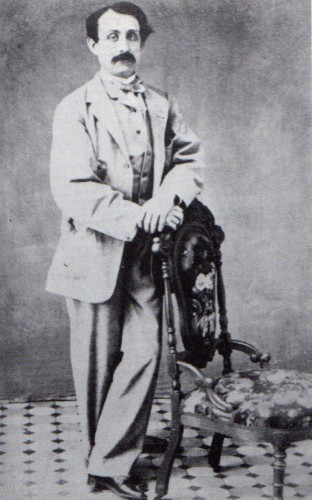
Note the suit Gottschalk is wearing. It is similar to, and perhaps the same as, the one in the stereoscopic view above. And take a look at the tile floor in both this photograph and the stereoscopic view–they appear to be one and the same. The floor, in particular, leads me to believe that both of the above photographs were taken in the same photographic studio.
Now take a look at this photograph, which was also in Bamboula:
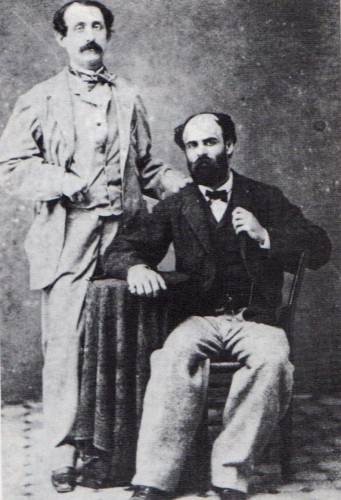
That is Gottschalk at left, in suit similar to the one he is wearing in the stereoscopic view. Note, though, that the tie Gottschalk is wearing above has some dark printing on it, unlike that in the stereoscopic view, which seems to be a light color throughout. But one of the friends who appears in the stereoscopic view is wearing the same outfit above and the same floor is shown in both photographs. He is identified in Bamboula as George William Warren. Here’s how Fred Starr introduced Warren in Bamboula:
In the audience at the same concert in Albany [in the autumn of 1855] was George William Warren (1828-1902), pianist and organist . . . . Robust and full-bearded, . . . he and Gottschalk stood on opposite sides of many fault lines running through American life. Warren was drawn at once to the composer from New Orleans, “I then heard him for the first time,” Warren recalled, “and succumbed at once. It was love at first sight–love for the man, his genius, his most extraordinary playing, and the utter (inner) simplicity of character, which I discovered at a glance.”
It was Warren who introduced Gottschalk and the painter Frederick Edwin Church; Gottschalk and Warren would later write the music, The Andes, that provided the accompaniment to the exhibition of Church’s monumental painting “Heart of the Andes.” It was displayed, with an admission price, at the Groupil Gallery on Broadway in New York City. Visitors were given metal tubes through which to view the painting–that’s how realistic it was considered to be. You were not looking at a painting–rather, you were looking through a telescope-like tube at the Andes themselves!
And, as a bonus, the photograph of Gottschalk and Warren is identified in Bamboula as having been taken at Saratoga, New York (the Hampstons of its time) in 1864. Wow! Place and year. It appears, given the similarity of the floor and the outfits the men are wearing, as well as Gottschalk’s mustache, Warren’s beard, and the similarity of their facial characteristics and hair (note, in particular, the hair on the left side of Warren’s head–there is a similar tongue of hair coming forward towards his face in both photographs), as well as what appears to be the same outfit that Warren is wearing in both photographs, that the stereoscopic view likely was taken in Saratoga that same day or within a few days of the photograph that appears in Bamboula of Gottschalk and Warren.
As to the third individual in the stereoscopic view (the other friend), he does seem to have quite a resemblance to the man shown in this photograph in Bamboula:
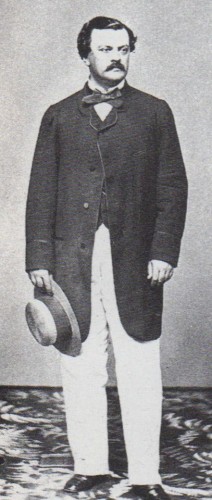
Professor Starr, in Bamboula, identifies this man as Pasquale Brignoli, a tenor and Gottschalk crony. Gottschalk and Brignoli had been friends in Paris; they had renewed acquaintances in 1855. Walt Whitman admired Brignoli for his “perfect singing voice” with its “tremulous, manly timbre.” I thought it looked like the man in the group stereographic photo; Professor Starr thinks that is likely.
It looks like the mystery of the friends is solved.
I am sorry to have to disagree with you and Prof. Starr, but I am almost completely certain that the third man is _not_ Brignoli. The man in the stereo photo has bluish-grey eyes (which didn’t register well on 1860s photographic emulsions; Brignoli, Gottschalk, and Warren’s eyes are dark), lighter hair, a much higher forehead, and a much longer and thinner face than Brignoli. I’m not sure who it could be, though, other than it isn’t Richard Hoffman, another close friend of Gottschalk and Warren. One way to investigate is to look at the Saratoga newspapers of the period, which heavily detailed society doings of visitors like Gottschalk and other prominent New York musicians. A name might pop out; I’m going to investigate further myself.
Thanks for sharing your thoughts on this. Please get back to us if you find anything. Thanks!